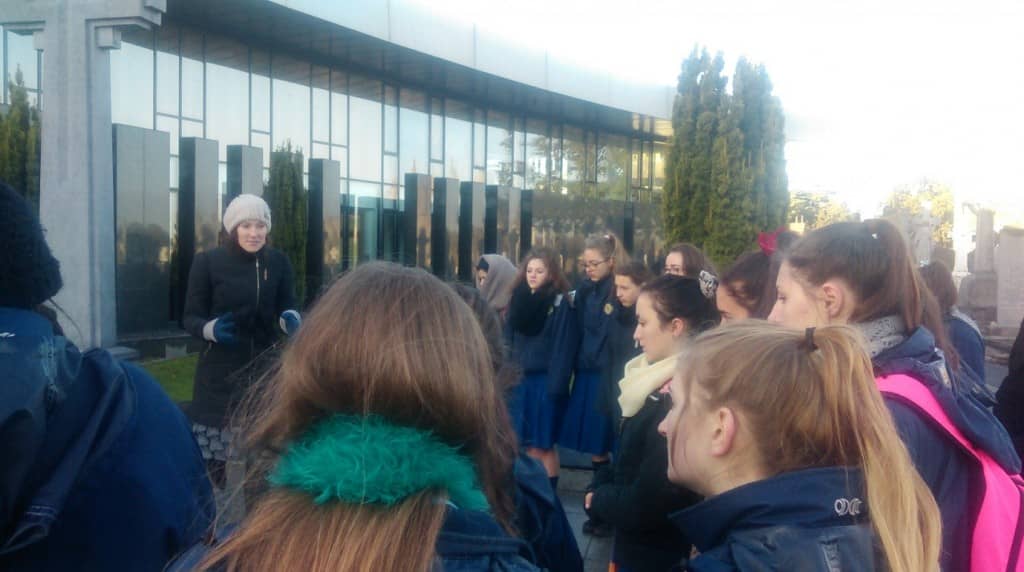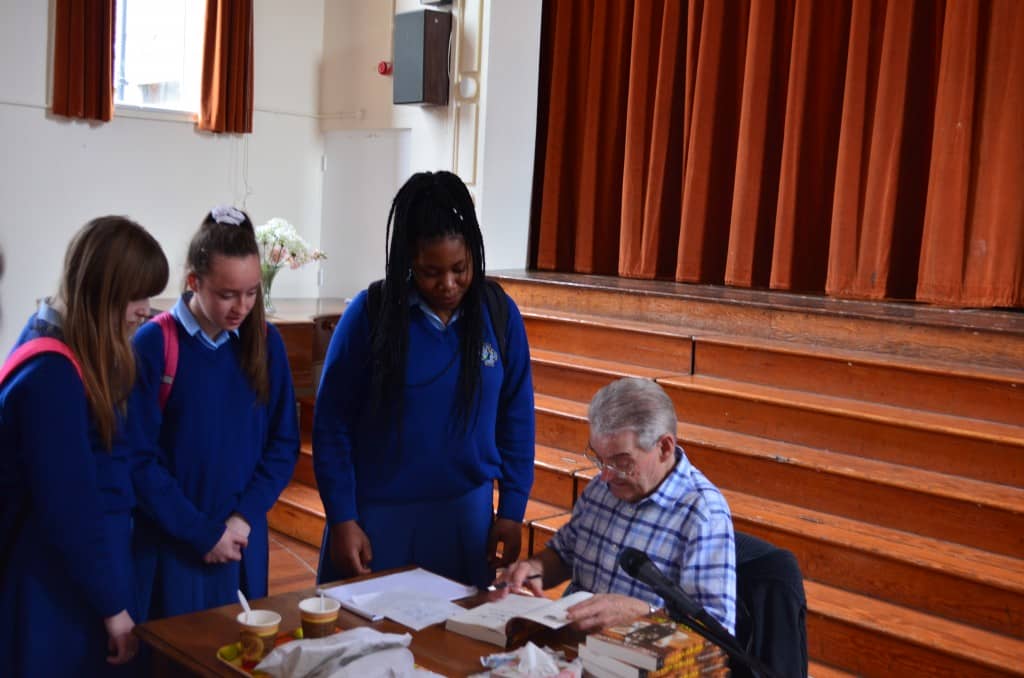Organised by Ms Townshend and Mr McQuillan on the 17th December, 2021.
TY Trip to Glasnevin Cemetery
On Monday the 7th of November Transition Years spent a bitterly cold morning on a tour of Glasnevin Cemetery. Our first stop was Daniel O’Connell’s grave. He lies buried beneath its most eye-catching architectural feature: a round tower, the tallest in Ireland. Even his relatives are buried within the crypt. The tower had stairs but these were blown up in 1971 by loyalists and are about to be reconstructed. We were very privileged to be among the last few visitors to see the tower without stairs.
We also saw the grave of Charles Stewart Parnell. He is reported as having had the largest funeral ever experienced by the cemetery. People who attended said they witnessed a large bright light in the sky at the time of his funeral. It was later discovered that this was in fact a meteor.
I was surprised by the simplicity of the grave of Éamon de Valera, considering his significant political career which spanned over half a century, from 1917 to 1973. He had been both Taoiseach and President on more than one occasion. Éamon de Valera’s son had died at the age of twenty in a horse riding accident. De Valera wished to be buried in the same grave as his son. His wife Sinéad is also buried there.
The most colourful grave was definitely that of Michael Collins as it was adorned with lots of fresh flowers. Our guide spoke about how Collins was able to keep his identity a secret as no one knew what he looked like for years. He was only thirty one when he died and the Irish Independent reported on the ‘greatest pageant of sorrow ever seen in Dublin: a cortège three miles long.’
Following a very fascinating tour we visited the Glasnevin Museum Exhibition where we learned about the grave diggers and the various religious denominations of those buried in the cemetery. We also accessed the digitally interactive timeline and the genealogical records which were relevant to many of our own families.
I thoroughly enjoyed the trip, despite the cold, and I hope to return. I am looking forward to exploring Glasnevin’s genealogy records in the future.
Katie Clarke (4S)

Tomi Reichental Visits Maryfield

On 14th October 2014 Transition Year and Leaving Certificate History students were given the opportunity to listen to Tomi Reichental, a survivor of the World War II Nazi Bergen-Belsen concentration camp, speak about his horrific experience. By now there are very few survivors of Nazi brutality and we were therefore honoured to have Mr. Reichental visit our school.
Tomi described his childhood before the war in Slovakia, how Nazi anti-Semitic laws affected him and recalled being bullied for being a Jew. He remembered wearing a yellow star and explained how his family were arrested. Students and teachers sat in complete silence as he spoke. It was difficult to listen to his reminiscences as he recalled the appalling conditions which he experienced for seven days in a carriage with no windows or toilets during a freezing November in 1944 while travelling to the camp. He was only nine years old and alas this was only a sample of the nightmare ahead. He explained to students how the Jewish population in Slovakia dropped from approximately 90,000 to 25,000 as Nazis murdered his people in concentration camps across Germany.
In Bergen-Belsen he actually played among corpses. He also remembers watching his grandmother’s corpse being thrown on a pile of rotting bodies like an old rag doll. He lost thirty five members of his family. Luckily Tomi survived until the liberation in 1945. He recalled that despite the absence of guards the inmates were too afraid to leave. Eventually the Allies arrived and provided them with food. But this was a bad idea as their stomachs had shrunk and many people continued to die as they could not digest it.
He eventually returned to his home town in Slovakia. Despite the fact that the war was over, attitudes towards Jews had not changed. As a teenager he emigrated to Israel, later moving to Germany to become an engineer. In the late 1950s he eventually moved to Ireland and married an Irish girl and had three children.
It took fifty years before Tomi could speak about what happened to him. He now travels all around Ireland as well as different countries to speak about his experience during the Holocaust. He has written a book ‘I was a Boy in Belsen’. Students were able to buy signed copies at the end of his talk.
We would sincerely like to thank Tomi Reichental for taking the time out of his very busy schedule to come to Maryfield College and share his experience with us. We would also like to thank Nora Moore, Aoife Moore’s mother, and Rosemary from the Holocaust Education Trust Ireland, www.hetireland.org who helped organise Tomi’s visit to the school.
By Chloe Walker and Clare Brown (with the assistance of Ms.Townshend)